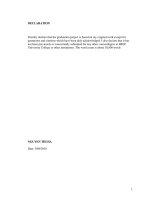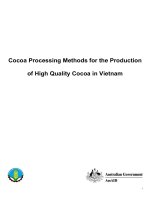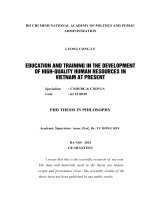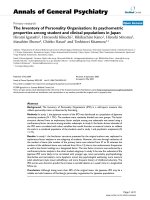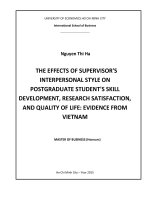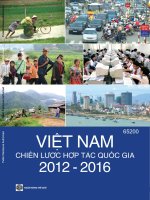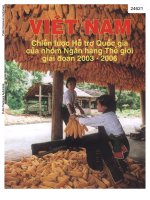JAPAN INTERNATIONAL COOPERATION AGENCY (JICA) VIETNAM RAILWAYS (VR) STUDY FOR THE FORMULATION OF HIGH SPEED RAILWAY PROJECTS ON HANOI – VINH AND HO CHI MINH – NHA TRANG SECTION FINAL REPORT VOLUME I DEVELOPMENT OF NORTH-SOUTH RAILWAYS JUNE 2013 REPORT
Bạn đang xem bản rút gọn của tài liệu. Xem và tải ngay bản đầy đủ của tài liệu tại đây (7.05 MB, 441 trang )
JAPAN INTERNATIONAL COOPERATION AGENCY (JICA)
VIETNAM RAILWAYS (VR)
STUDY FOR THE FORMULATION OF HIGH SPEED RAILWAY
PROJECTS ON HANOI – VINH AND HO CHI MINH – NHA TRANG
SECTION
FINAL REPORT
VOLUME I
DEVELOPMENT OF NORTH-SOUTH RAILWAYS
June 2013
ALMEC CORPORATION
JAPAN INTERNATIONAL CONSULTANTS FOR TRANSPORTATION CO., LTD.
ORIENTAL CONSULTANTS CO., LTD.
NIPPON KOEI CO., LTD.
JAPAN TRANSPORTATION CONSULTANTS, INC.
Exchange rate used in the Report
USD 1 = JPY 78 = VND 21,000
(Based on rate on November 2011)
PREFACE
In response to the request from the Government of the Socialist Republic of Vietnam, the
Government of Japan decided to conduct the Study for the Formulation of High Speed Railway
Projects on Hanoi – Vinh and Ho Chi Minh – Nha Trang Section and entrusted the program to
the Japan International cooperation Agency (JICA).
JICA dispatched a team to Vietnam between April 2011 and June 2013, which was headed
by Mr. IWATA Shizuo of ALMEC Corporation and consisted of ALMEC Corporation, Japan
International Consultants for Transportation Co., Ltd., Oriental Consultants Co., Ltd., Nippon
Koei Co., Ltd. and Japan Transportation Consultants, Inc.
In the cooperation with the Vietnamese Counterpart Team including the Ministry of
Transport and Vietnam Railways, the JICA Study Team conducted the study which includes
traffic demand analysis, natural and socio-economic conditions, alignment planning,
consideration of various options including the upgrading of existing railway, technical
standards for high speed railway, implementation schedule and institutions, and human
resource development. It also held a series of discussions with the relevant officials of the
Government of Vietnam. Upon returning to Japan, the Team duly finalized the study and
delivered this report in June 2013.
Reflecting on the history of railway development in Japan, it is noted that Japan has indeed
a great deal of experience in the planning, construction, operation, etc., and it is deemed that
such experiences will greatly contribute to the railway development in Vietnam. JICA is
willing to provide further cooperation to Vietnam to achieve sustainable development of railway
sector and to enhance friendly relationship between the two countries.
It is hoped that this report will contribute to the sustainable development of transport
system in Vietnam and to the enhancement of friendly relations between the two countries.
Finally, I wish to express my sincere appreciation to the officials of the Government of
Vietnam for their close cooperation.
June 2013
Kazuki Miura
Director, Economic Infrastructure Department
Japan International Cooperation Agency
TABLE OF CONTENTS
1 INTRODUCTION
1.1 Background and Objectives of the Study ............................................................................. 1-1
1.2 Study Implementation........................................................................................................... 1-3
1.3 Structure of the Final Report ................................................................................................ 1-9
2 REVIEW OF CURRENT SITUAION AND FUTURE TRANSPORTATION DEVELOPMENT
DIRECTION FOR NORTH – SOUTH CORRIDOR
2.1 Natural Conditions ............................................................................................................... 2-1
2.2 Socio-economic Conditions.................................................................................................. 2-6
2.3 Current Transportation Network and Services along North-South Corridor........................ 2-12
2.4 Overall Traffic Demand and Characteristics ....................................................................... 2-21
2.5 Current Government Policy and Plan................................................................................. 2-33
3 CONSTRAINTS AND OPPORTUNITIES OF THE EXISTING NORTH-SOUTH RAILWAY
LINE
3.1 Existing Conditions of the North-South Railway ................................................................... 3-1
3.2 Main Bottlenecks in Existing Railway ................................................................................... 3-7
3.3 Opportunities and Constraints to Improvement of Existing Line......................................... 3-14
3.4 Alternative Improvements for the North-South Railway Line .............................................. 3-22
4 ALTERNATIVE SCENARIO FOR NORTH-SOUTH RAILWAY DEVELOPMENT
4.1 Review of Alternative Scenarios discussed in National Assembly........................................ 4-1
4.2 Traffic Demand Analysis....................................................................................................... 4-5
4.3 Preliminary Economic Evaluation of North-South Railway Development ........................... 4-26
5 ANALYSIS AND SELECTION OF HSR SYSTEM AND TECHNOLOGY
5.1 Review of High-Speed Railway Technologies in the World .................................................. 5-1
5.2 Comparison of High-Speed Railway Technologies and Subsystem ................................... 5-29
5.3 Selection of Appropriate System Technologies for HSR in Vietnam ................................... 5-87
6 IMPLEMENTATION DIRECTIONS AND KEY AREAS FOR CONSIDERATIONS
6.1 Proposed Overall Roadmap for HSR Development ............................................................. 6-1
6.2 HSR Initial Section ............................................................................................................... 6-4
6.3 Operation and Management Organization ......................................................................... 6-13
6.4 Human Resource Development ......................................................................................... 6-39
6.5 Funding Options................................................................................................................. 6-59
6.6 Necessary Institutions and Legislation for Introducing High Speed Railway ...................... 6-71
6.7 The Nature of Railway Industry and How to Raise Supporting Industries .......................... 6-78
6.8 Environmental and Social Considerations.......................................................................... 6-79
7 CONCLUSION AND RECOMMENDATIONS
iii
APPENDIX Life Cycle for Each Track Structure
Railway Technical Research Institute (RTRI) Report
APPENDIX 5A Existing Law and Standard Concerning to Railway Construction
APPENDIX 5B Institutional Framework for Construction and Operation of Japan’s HSR
APPENDIX 6A Current Institutional Situation of Vietnam Railway Project Implementation
APPENDIX 6B
APPENDIX 6C
iv
Table 1.2.1 LIST OF TABLES
Table 1.2.2
Table 1.2.3 Main Meetings held ..................................................................................................... 1-5
Table 2.1.1 List of Organizations Attended Stakeholder Meeting .................................................. 1-6
Table 2.2.1 Activities of Counterpart Study Tour ............................................................................ 1-8
Table 2.2.2 Characteristics of Climate Zones in Vietnam .............................................................. 2-2
Table 2.2.3 Historical Demographic Change in Vietnam ............................................................... 2-6
Table 2.2.4 Historical Demographic Change in Vietnam ............................................................... 2-6
Table 2.2.5 Development Indicators for Provinces along North – South Corridor......................... 2-9
Table 2.3.1 Future Growth of Provinces ........................................................................................ 2-9
Table 2.3.2 Future Growth of Cities ............................................................................................. 2-11
Table 2.3.3 Transport Infrastructure of North-South Corridor ...................................................... 2-12
Table 2.3.4 Average Fare to Terminals ........................................................................................ 2-15
Table 2.3.5 Average Access Time to Terminal (minutes)............................................................. 2-15
Table 2.3.6 List of Expressway Projects in the MOT Master Plan ............................................... 2-17
Table 2.4.1 Committed/On-going Projects of Aviation Sector...................................................... 2-19
Table 2.4.2 Proposed Projects of Aviation Sector........................................................................ 2-19
Table 2.4.3 Forecast Increase in Passenger and Freight Traffic ................................................. 2-21
Table 2.4.4 Estimated Traffic Demand along North South Corridor (Baseline Scenario) 2030... 2-24
Table 2.4.5 Railway Traffic Demand by Line ............................................................................... 2-25
Table 2.4.6 Major OD Pairs of Railway Passenger Traffic (Hanoi–Saigon Line)......................... 2-26
Table 2.4.7 Cross Section Passenger Traffic Volume of Hanoi–Saigon Line .............................. 2-28
Table 2.4.8 Freight Traffic Demand by Line ................................................................................. 2-28
Table 2.4.9 Major OD Pairs of Railway Cargo Traffic .................................................................. 2-29
Table 2.4.10 Cross Sectional Cargo Traffic Volume of Hanoi–Saigon Line .................................. 2-30
Table 2.5.1 Traffic Volume at Major Airports in Vietnam .............................................................. 2-30
Table 2.5.2 Summary of the Cargo Throughput of Ports in Vietnam (2007-2010) ...................... 2-32
Table 3.1.1 Transport Development Orientation up to 2020........................................................ 2-36
Table 3.2.1 Summary of Railway Transport Master Plan ............................................................ 2-37
Table 3.2.2 Profile of Existing Line ................................................................................................ 3-1
Table 3.3.1 Identified Main Problems of Existing Railways ........................................................... 3-7
Table 3.4.1 Distance between Stations and Characteristics of Curvature................................... 3-13
Table 3.4.2 International Practices of Mixed Operation of Passenger and Freight Transport ..... 3-17
Table 3.4.3 Estimated Investment Cost of Alternative A2 ............................................................ 3-25
Table 3.4.4 Cost Breakdown of Alternative A2............................................................................. 3-25
Table 3.4.5 Estimated Investment Cost of Alternative B1............................................................ 3-28
Table 3.4.6 Cost Breakdown of Alternative B1 ............................................................................ 3-28
Table 3.4.7 Estimated Investment Cost of Alternative B2............................................................ 3-31
Table 3.4.8 Cost Breakdown of Alternative B2 ............................................................................ 3-31
Table 3.4.9 Summary of Four Alternatives (A1, A2, B1 and B2).................................................. 3-34
Table 4.1.1 Investment Cost of Improvement Plans of Existing Railway .................................... 3-35
Table 4.2.1 Passenger Demand related to Hue – Danang Section............................................. 3-37
Table 4.2.2 Steps for Review and Reorganization of Alternative Scenario ................................... 4-2
Table 4.2.3 Load Factor of Car and Bus........................................................................................ 4-7
Table 4.2.4 Assumed Gasoline Price for Car................................................................................. 4-8
Table 4.2.5 Assumed Fare for Public Transporation ..................................................................... 4-9
Expressway Toll (per Passenger-distance)................................................................. 4-9
Waiting Time Obtained from Traffic Survey ................................................................ 4-9
v
Table 4.2.6 Assumed Time at Terminal ....................................................................................... 4-10
Table 4.2.7 Assumed Operating Condition by Mode ................................................................... 4-10
Table 4.2.8 Estimated Capacities of Transport Infrastructures .................................................... 4-11
Table 4.2.9 Estimated Capacities on North-South Corridor......................................................... 4-11
Table 4.2.10 Modal Shares of Freight Transportation, 2008 and 2030 ......................................... 4-12
Table 4.2.11 Cross Sectional Freight Traffic Demand in 2030 ...................................................... 4-13
Table 4.2.12 Scenarios for Analysis............................................................................................... 4-13
Table 4.2.13 Estimated Traffic Demand along North South Corridor (A1, A2), 2030 .................... 4-15
Table 4.2.14 Estimated Traffic Demand along North South Corridor (B1, B2), 2030 .................... 4-17
Table 4.2.15 Estimated Traffic Demand of Existing Railways ....................................................... 4-19
Table 4.2.16 Alternative Cases for Analysis .................................................................................. 4-20
Table 4.2.17 Impact of HSR on Traffic Demand by Mode along North-South Corridor (A2 Case),
2030 .......................................................................................................................... 4-21
Table 4.2.18 Impact of HSR on Traffic Demand by Mode along North-South Corridor (B1 Case),
2030 .......................................................................................................................... 4-23
Table 4.2.19 Estimated Railway Traffic Demand along the North-South Corridor, 2030............... 4-24
Table 4.3.1 Project Cost for Upgrading Existing Railway (for whole section)1/........................... 4-27
Table 4.3.2 Assumed Cost for Rolling Stock................................................................................ 4-27
Table 4.3.3 Applied O&M Costs................................................................................................... 4-27
Table 4.3.4 Assumed Passenger Time Costs .............................................................................. 4-28
Table 4.3.5 Vehicle Operating Cost (US$/1000 km) .................................................................... 4-29
Table 4.3.6 Operating Cost by Air Transport................................................................................ 4-29
Table 4.3.7 Operating Cost by Transportation Mode (Economic Cost) ....................................... 4-29
Table 4.3.8 Assumed Investment Schedule for Railway Projects ............................................... 4-30
Table 5.1.1 High-Speed Railways in the World.............................................................................. 5-1
Table 5.1.2 Japan’s Shinkansen (High-Speed New Lines)............................................................ 5-3
Table 5.1.3 Main Characteristics of TGV ....................................................................................... 5-8
Table 5.1.4 Main Characteristics of TGV Rolling Stock ............................................................... 5-10
Table 5.1.5 Main Characteristics of High-Speed Lines in Germany ............................................ 5-12
Table 5.1.6 Main Characteristics of ICE Rolling Stock ................................................................ 5-14
Table 5.1.7 Main Characteristics of Dirrettisima in Italy............................................................... 5-15
Table 5.1.8 Main Characteristics of High-speed Train in Italy ..................................................... 5-16
Table 5.1.9 Main Characteristics of High-Speed Lines in Spain .................................................. 5-18
Table 5.1.10 Main Characteristics of AVE / Avant / Alvia Rolling Stock ......................................... 5-19
Table 5.1.11 KTX Construction Specifications............................................................................... 5-21
Table 5.1.12 Outline of Electric Facility.......................................................................................... 5-21
Table 5.1.13 Basic Specifications of KTX ...................................................................................... 5-21
Table 5.1.14 Route Planning Data ................................................................................................. 5-23
Table 5.1.15 Outline of Electric Facility.......................................................................................... 5-24
Table 5.1.16 Basic Specifications of 700T ..................................................................................... 5-24
Table 5.1.17 High-Speed Railways Opened in China.................................................................... 5-25
Table 5.1.18 Design Standards for High-Speed Railways in China............................................... 5-25
Table 5.1.19 List of Rolling Stock Performance used for Chinese High-Speed Railways ............. 5-28
Table 5.2.1 Traffic Volumes of High-Speed Rail .......................................................................... 5-30
Table 5.2.2 Comparison of Tunnel Fire Protection ...................................................................... 5-32
Table 5.2.3 Construction Specifications of TGV and Shinkansen ............................................... 5-34
Table 5.2.4 Construction Specification of Taiwan HSR, Korea HSR, TGV Atlantique, and ICE, and Italy
ETR .................................................................................................................................... 5-35
vi
Table 5.2.5 Maximum Rolling Stock’s Width in Typical HSR ....................................................... 5-38
Table 5.2.6 Comparison of HSR civil Structures.......................................................................... 5-39
Table 5.2.7 Main Technical Characteristics of Tracks for High Speed Railway in the World....... 5-42
Table 5.2.8 New Stations in Top 5 Countries of HSR Infrastructure ............................................ 5-46
Table 5.2.9 Interchange HSR Station in Japan............................................................................ 5-52
Table 5.2.10 A Comparison between Different Types of Cards .................................................... 5-53
Table 5.2.11 Merits and Demerits of Articulated Bogie System..................................................... 5-58
Table 5.2.12 Merits and Demerits of Power Concentrated System and Power Distributed System . 5-
59
Table 5.2.13 Comparison of World High Speed Rolling Stock....................................................... 5-60
Table 5.2.14 Signal Systems of Major High-Speed Railways in the World ................................... 5-61
Table 5.2.15 Train Radio Systems ................................................................................................. 5-67
Table 5.2.16 Level and Interval of Inspection of Rolling Stock in Germany (ICE), France (TGV) and
Japan ........................................................................................................................ 5-75
Table 5.2.17 Maintenance of High Speed Rail Line in the World .................................................. 5-76
Table 5.2.18 Trend of Train Number in the Tokaido-Sanyo Shinkansen ....................................... 5-80
Table 5.2.19 Function Comparisons of the Operation Controlling System.................................... 5-86
Table 5.3.1 A Variety of Train Series of Shinkansen.................................................................... 5-90
Table 5.3.2 Comparison of Tunnel Fire Protection ...................................................................... 5-91
Table 5.3.3 Specifications for the Construction Standard of Vietnam High-Speed Railway ........ 5-93
Table 5.3.4 Number of Boarding/Alighting Passengers at Different Stations in the Ngoc Hoi–Vinh
Section ...................................................................................................................... 5-94
Table 5.3.5 Number of Boarding/Alighting Passengers at Different Stations in the Nha Trang–Thu
Thiem Section ........................................................................................................... 5-94
Table 5.3.6 Stoppage/Passage Patterns, Tohoku Shinkansen .................................................... 5-94
Table 5.3.7 Principle of Stoppage/Passage Patterns .................................................................. 5-95
Table 5.3.8 Stoppage Type B ....................................................................................................... 5-95
Table 5.3.9 Composition of a Shinkansen Train Set1/................................................................. 5-95
Table 5.3.10 Brake Deceleration ................................................................................................... 5-96
Table 5.3.11 Passage Patterns throughout the Ngoc Hoi–Vinh Section ....................................... 5-96
Table 5.3.12 Two-Station Stoppage Patterns in the Ngoc Hoi–Vinh Section................................. 5-97
Table 5.3.13 Four-Station Stoppage Patterns in the Ngoc Hoi–Vinh Section................................ 5-97
Table 5.3.14 Passage Patterns throughout the Nha Trang–Thu Thiem Section ........................... 5-97
Table 5.3.15 One-station Stoppage Patterns in the Nha Trang–Thu Thiem Section..................... 5-97
Table 5.3.16 Two-station Stoppage Patterns in the Nha Trang–Thu Thiem Section ..................... 5-98
Table 5.3.17 Three-station Stoppage Patterns in the Nha Trang–Thu Thiem Section .................. 5-98
Table 5.3.18 Four-station Stoppage Patterns in the Nha Trang–Thu Thiem Section .................... 5-98
Table 5.3.19 Types and Performances of Slope-Protection Works for Embankments................ 5-102
Table 5.3.20 Types and Performances of Slope-Protection Works for Cuttings ......................... 5-103
Table 5.3.21 Design Limit Values for Girder Deflection Based on Running Safety under Normal
Conditions ................................................................................................................ 5-106
Table 5.3.22 Design Limit Values of Vertical Unevenness of Track Surface Based on Running
Safety under Normal Conditions ............................................................................. 5-106
Table 5.3.23 Design Limit Values for Angular Rotation of Track Surface Based on Running Safety
under Normal Conditions ........................................................................................ 5-106
Table 5.3.24 Limit Values for Differential Displacement of Track Surface during Earthquake .... 5-106
Table 5.3.25 Comparison of Tunnel Cross-Sectional Areas in Various Countries....................... 5-109
Table 5.3.26 Features of Main Track Structures and Life Cycle Cost in Vietnam ........................5-111
vii
Table 5.3.27 Management of Disadvantages of Ballast Track .....................................................5-111
Table 5.3.28 Proposed Track Structures for Various Type of Civil Structures ............................. 5-115
Table 5.3.29 Proposed Track Structure and Material Specifications ........................................... 5-118
Table 5.3.30 Characteristics of Main Turnouts and Their Proposed Application in Vietnam HSR5-119
Table 5.3.31 Basic Concepts, Requirements and Solutions of Vietnam High Speed Rolling Stock
................................................................................................................................ 5-124
Table 5.3.32 Basic Specification of Vietnam High Speed Rolling Stock ...................................... 5-124
Table 5.3.33 Maintenance System of Vietnam High Speed Rolling Stock .................................. 5-129
Table 5.3.34 Design Conditions for Optical Carrier Circuits ........................................................ 5-134
Table 5.3.35 Objects of the Centralized Monitoring System........................................................ 5-136
Table 5.3.36 Voltage of the Overhead Contact Wire ................................................................... 5-139
Table 5.3.37 Unbalance Ratio and Fluctuation of Voltage........................................................... 5-141
Table 5.3.38 Kind and Standard Tension of Messenger Wire and Contact Wire......................... 5-143
Table 5.3.39 Kind and Standard Tension of Feeder..................................................................... 5-143
Table 5.3.40 Standard Spans....................................................................................................... 5-144
Table 5.3.41 Level and Interval of Rolling Stock Inspection ........................................................ 5-147
Table 6.2.1 Length of Initial Section by Target Running Speed ..................................................... 6-6
Table 6.2.2 Outline of Candidate Initial Sections ........................................................................... 6-9
Table 6.2.3 Approximate Project Costs for Candidate Initial Sections (US$ million)................... 6-10
Table 6.2.4 Passenger Demand between Hanoi and Ha Nam.................................................... 6-11
Table 6.2.5 Estimate of Long Thanh Airport Traffic Demand, 2030 ............................................. 6-11
Table 6.3.1 Tokaido Shinkansen Personnel at Its Inauguration................................................... 6-21
Table 6.4.1 Main Technology Introduced to the Shinkansen and Needed Expertise .................. 6-41
Table 6.4.2 Number of Employees for Tests and Training ........................................................... 6-49
Table 6.4.3 Overseas Training Tours and Technological Training in Japan................................. 6-54
Table 6.4.4 Acquisition of Urban Railway (UMRT Line 1) Technologies and Initial Section
Construction .............................................................................................................. 6-54
Table 6.4.5 Training at the Initial Section Training Center ........................................................... 6-54
Table 6.4.6 Training after HSR Initial Section .............................................................................. 6-54
Table 6.4.7 Formulation of Rules for Different Fields in the Shinkansen in Japan ...................... 6-56
Table 6.5.1 Responsibilities of Private and Public Sector in HSR Management......................... 6-59
Table 6.5.3 Responsibilities in HSR Management ...................................................................... 6-68
Table 6.5.4 Risk Shares Before Completion................................................................................ 6-69
Table 6.5.5 Risk Shares After Completion ................................................................................... 6-69
Table 6.5.6 Common Risk Shares ............................................................................................... 6-70
Table 6.6.1 Desirable Period of Institution Preparation ............................................................... 6-77
viii
LIST OF FIGURES
Figure 1.1.1 Location of the NSHSR Project Sections and Neighboring Cities .............................. 1-2
Figure 1.2.1 Study Organization...................................................................................................... 1-3
Figure 1.2.2 Overall Work Flow of the Study................................................................................... 1-4
Figure 2.1.1 Topographic Conditions of the North – South Corridor ............................................... 2-1
Figure 2.1.1 Annual Rainfall Distribution in Vietnam....................................................................... 2-3
Figure 2.1.2 Proportion of Reported................................................................................................ 2-3
Figure 2.1.3 Distribution of Environmentally Sensitive Areas ......................................................... 2-5
Figure 2.2.1 Change in Population, Urbanization and GRDP......................................................... 2-7
Figure 2.2.2 Distribution of Main Cities along North-South Corridor............................................. 2-10
Figure 2.3.1 Spatial Structure and Transportation along the North – South Corridor ................... 2-13
Figure 2.3.2 Access Mode to Transportation Terminals ................................................................ 2-14
Figure 2.3.3 Comparative Evaluation of All Travel Modes ............................................................ 2-15
Figure 2.3.4 Identified Road and Road Transportation Projects up to 2030 (Expressway) .......... 2-16
Figure 2.3.5 Identified Air Transportation Projects up to 2030 ...................................................... 2-18
Figure 2.4.1 Passenger Traffic Demand Distribution, 2010 and 2030 .......................................... 2-22
Figure 2.4.2 Freight Traffic Demand Distribution, 2010 and 2030 ................................................ 2-22
Figure 2.4.3 Passenger Traffic Demand by Mode along North-South Coastal Corridor, 2010 ..... 2-23
Figure 2.4.4 Freight Traffic Demand by Mode along North-South Coastal Corridor, 2010 ........... 2-24
Figure 2.4.5 Estimated Traffic Demand along North South Corridor (Baseline Scenario) 2030... 2-25
Figure 2.4.6 Trend of Top 5 Major Pasenger OD Pairs (Hanoi–Saigon Line) ............................... 2-26
Figure 2.4.7 No. of Passengers by Railway Station on Hanoi–Saigon Line, 2010 ....................... 2-27
Figure 2.4.8 Distribution of Passenger Trip Length on Hanoi – Saigon Line in 2010 ................... 2-27
Figure 2.4.9 Railway Cargo Handling Tonnage by Station, 2010.................................................. 2-29
Figure 2.4.10 Distribution of Railway Cargo Haulage (all Lines), 2010 .......................................... 2-30
Figure 2.4.11 Traffic Volume at Major Airports in Vietnam .............................................................. 2-31
Figure 2.4.12 No. of Annual Domestic Air Passenger by Operating Company............................... 2-31
Figure 3.1.1 Examples of Current Situation of Existing Railway..................................................... 3-5
Figure 3.2.1 Locations of Bottlenecks ............................................................................................. 3-8
Figure 3.2.2 Realignment Plan Map of Hai Van Pass ................................................................... 3-10
Figure 3.2.3 Realignment Sketch Plan of Hai Van Pass ............................................................... 3-10
Figure 3.2.4 Realignment Plan of Khe Net Pass........................................................................... 3-11
Figure 3.2.5 Hoa Duyet – Thanh Luyen Section Upgrade Project................................................ 3-12
Figure 3.2.6 Switchback Sections in Danang and Nha Trang....................................................... 3-13
Figure 3.3.1 Dual Gauge (Photo) .................................................................................................. 3-15
Figure 3.3.2 Japanese Experiences of Gauge Conversion .......................................................... 3-15
Figure 3.3.3 Track Layout of Dual Gauge ..................................................................................... 3-16
Figure 3.3.4 Passenger and Freight Train Operation Diagram ..................................................... 3-21
Figure 3.4.1 Image of Option A1 ................................................................................................... 3-23
Figure 3.4.2 Image of Option A2 ................................................................................................... 3-26
Figure 3.4.3 Image of Option B1 ................................................................................................... 3-29
Figure 3.4.4 Image of Option B2 ................................................................................................... 3-33
Figure 4.2.1 Flow of Traffic Demand Analysis (Passenger) ............................................................ 4-5
Figure 4.2.2 New Zones for Target Area ......................................................................................... 4-6
Figure 4.2.3 “Do Something” Network............................................................................................. 4-8
Figure 4.2.4 Cross Sectional Freight Demand on North South Corridor (2010) ........................... 4-12
Figure 4.2.5 Cross Sectional Freight Demand on North South Corridor (2030) ........................... 4-12
ix
Figure 4.2.6 Estimated Traffic Demand along North South Corridor (A1, A2), 2030 .................... 4-16
Figure 4.2.7 Estimated Traffic Demand along North South Corridor (B1, B2), 2030 .................... 4-18
Figure 4.2.8 Demand Supply Gap of Existing Railway (no. of trains/day/both directions): Passener
and Freight (Service Level of Existing Railway is A2)............................................... 4-19
Figure 4.2.9 Impact of HSR on Traffic Demand by Mode along North-South Corridor (A2 Case),
2030 .......................................................................................................................... 4-22
Figure 4.2.10 Impact of HSR on Traffic Demand by Mode along North-South Corridor (B1 Case),
2030 .......................................................................................................................... 4-23
Figure 4.3.1 Basic Framework of Economic Evaluation ............................................................... 4-26
Figure 5.1.1 Network of Japan’s Shinkansen.................................................................................. 5-3
Figure 5.1.2 High-Speed Railway Network in France ..................................................................... 5-7
Figure 5.1.3 High-Speed Railway Network in Germany................................................................ 5-11
Figure 5.1.4 High-Speed Lines in Italy .......................................................................................... 5-15
Figure 5.1.5 High-Speed Railway Network in Spain ..................................................................... 5-17
Figure 5.1.6 High-Speed Railway Network in South Korea .......................................................... 5-20
Figure 5.1.7 High-Speed Railway Network in Taiwan ................................................................... 5-23
Figure 5.1.8 High-Speed Railway Network in China ..................................................................... 5-26
Figure 5.2.1 Earthwork Section and Ballast Track in Japan ......................................................... 5-42
Figure 5.2.2 Slab Track in Viaduct Section of Taiwan High Speed Railway.................................. 5-42
Figure 5.2.3 Earthwork Section and Ballast Track in TGV Sud-Est Line ...................................... 5-43
Figure 5.2.4 Typical Cross Section of Earthwork Section of TGV................................................. 5-43
Figure 5.2.5 RHEDA2000.............................................................................................................. 5-43
Figure 5.2.6 Photos on Rail Fastenings ........................................................................................ 5-45
Figure 5.2.7 New Stations on Bejing-Shanghai HSR, China ........................................................ 5-47
Figure 5.2.8 New Stations on Kyushu Shinkansen, Japan ........................................................... 5-48
Figure 5.2.9 New Stations on Madrid–Valencia/Albacete, Spain .................................................. 5-49
Figure 5.2.10 New Stations on the LGV Est, France ...................................................................... 5-50
Figure 5.2.11 New Stations on Nurenberg-Ingolstadt, German ...................................................... 5-51
Figure 5.2.12 Series E5................................................................................................................... 5-54
Figure 5.2.13 Series N700 .............................................................................................................. 5-55
Figure 5.2.14 TGV-POS .................................................................................................................. 5-55
Figure 5.2.15 AGV........................................................................................................................... 5-56
Figure 5.2.16 ICE3 .......................................................................................................................... 5-57
Figure 5.2.17 CRH3C ...................................................................................................................... 5-57
.Figure 5.2.18 Articulated Bogie of TGV .......................................................................................... 5-58
Figure 5.2.19 Train Control by DS-ATC (An Example of Midway Stopping) ................................... 5-62
Figure 5.2.20 Train Control by DS-ATC (An Example of Stopping at a Station) ............................. 5-62
Figure 5.2.21 TGV Signal System (TVM430).................................................................................. 5-63
Figure 5.2.22 German ICE Signal System (LZB) ............................................................................ 5-64
Figure 5.2.23 The Signal System for the Italian High-Speed Railways........................................... 5-65
Figure 5.2.24 A Comparison of the Levels 1, 2 and 3 of ETCS ...................................................... 5-66
Figure 5.2.25 Cyclic Single-Phase Power Receiving System ......................................................... 5-68
Figure 5.2.26 Three Phase Power Receiving System .................................................................... 5-68
Figure 5.2.27 Booster Transformer Feeding System ...................................................................... 5-70
Figure 5.2.28 Auto Transformer Feeding System ........................................................................... 5-70
Figure 5.2.29 Dead section in France TGV..................................................................................... 5-71
Figure 5.2.30 Configuration of Changeover Section ....................................................................... 5-72
Figure 5.2.31 Simple Catenary System .......................................................................................... 5-73
x
Figure 5.2.32 Stitched Simple Catenary System............................................................................. 5-73
Figure 5.2.33 1 Track Layout on the Lines for High-Speed Operation............................................ 5-77
Figure 5.2.34 2 Lines....................................................................................................................... 5-78
Figure 5.2.35 Progress of Train Operation Methods ....................................................................... 5-79
Figure 5.2.36 Autonomous and Decentralized System................................................................... 5-81
Figure 5.2.37 Advantage of Autonomous and Decentralized System............................................. 5-81
Figure 5.2.38 8 Sub-Systems of COSMOS..................................................................................... 5-82
Figure 5.2.39 The Reason Why COCMOS Adapted Forecast Operation Schedule for the Train
Controlling ................................................................................................................. 5-82
Figure 5.2.40 Maintenance Work Control System .......................................................................... 5-83
Figure 5.2.41 Change of the Dispatchers’ Roles............................................................................. 5-84
Figure 5.2.42 ATP Methods in Europa ............................................................................................ 5-85
Figure 5.2.43 ERTMS Worldwide Situations ................................................................................... 5-85
Figure 5.3.1 Train Performance Curve in the Ngoc Hoi–Vinh Section.......................................... 5-99
Figure 5.3.2 Train Performance Curve in the Thu Thiem–Nha Trang Section.............................. 5-99
Figure 5.3.3 Track Layouts in Different Station Yard ................................................................... 5-100
Figure 5.3.4 Track Layouts in Different Station Yard ................................................................... 5-100
Figure 5.3.5 Typical Embankment (H=3m) ................................................................................. 5-104
Figure 5.3.6 Typical Embankment (H=6m) ................................................................................. 5-104
Figure 5.3.7 Typical Embankment (H=9m) ................................................................................. 5-104
Figure 5.3.8 Typical Cutting (H=3m) ........................................................................................... 5-104
Figure 5.3.9 Typical Cutting (H=6m) ........................................................................................... 5-104
Figure 5.3.10 Typical Cutting (H=9m) ........................................................................................... 5-104
Figure 5.3.11 Typical Girder Type of Viaduct -1 ............................................................................ 5-105
Figure 5.3.12 Typical Girder Type of Viaduct -2 ............................................................................ 5-105
Figure 5.3.13 Continuous PC Girder ............................................................................................. 5-107
Figure 5.3.14 Steel Truss Bridge ................................................................................................... 5-107
Figure 5.3.15 3-Layer Structure .................................................................................................... 5-108
Figure 5.3.16 2-Layer Structure .................................................................................................... 5-108
Figure 5.3.17 1-Layer Structure .................................................................................................... 5-108
Figure 5.3.18 Canal Structure ....................................................................................................... 5-108
Figure 5.3.19 Typical Drawing of Box Culvert ............................................................................... 5-109
Figure 5.3.20 Typical Cross-Section of Tunnel ............................................................................. 5-110
Figure 5.3.21 Earthwork Section with Ballast Track...................................................................... 5-112
Figure 5.3.22 Features of Slab Track ............................................................................................ 5-114
Figure 5.3.23 Viaduct Section with Frame Type Slab Track in Taiwan High Speed Railway ........ 5-115
Figure 5.3.24 Tunnel Section with Frame-Shaped Slab Track...................................................... 5-115
Figure 5.3.25 Bridge Sleeper Track between Hanoi and Ninh Binh.............................................. 5-116
Figure 5.3.26 Directly Fastened Track on Steel Girder at Kubo River Bridge in Saga prefecture,
Japan ...................................................................................................................... 5-116
Figure 5.3.27 Elastic PC Sleeper for Ballast Track with Sleeper Pads ......................................... 5-117
Figure 5.3.28 Construction of Slab Track...................................................................................... 5-118
Figure 5.3.29 Example of Interoperable AFC System for Hanoi Area........................................... 5-120
Figure 5.3.30 Example of Interoperable AFC System for Hanoi Area........................................... 5-121
Figure 5.3.31 Automatic Passenger Gate ..................................................................................... 5-122
Figure 5.3.32 Processing at an Automatic Passenger Gate when a User Passes ....................... 5-122
Figure 5.3.33 Further Development of the Application of Interoperable AFC System .................. 5-123
Figure 5.3.34 Series E5................................................................................................................. 5-123
xi
Figure 5.3.35 Economy Class Car of Series E5............................................................................ 5-125
Figure 5.3.36 Executive Class Car of Series E5 ........................................................................... 5-125
Figure 5.3.37 Aluminum Double Skin Extruded Structure............................................................. 5-126
Figure 5.3.38 Long Nose Shape of Series E5............................................................................... 5-127
Figure 5.3.39 Low-noise Pantograph and Noise Reduction Plates .............................................. 5-127
Figure 5.3.40 Smooth Cover between Cars.................................................................................. 5-128
Figure 5.3.41 Full Bogie Cover and Sound-Absorbing Panels ..................................................... 5-128
Figure 5.3.42 Full-Active Suspension System .............................................................................. 5-129
Figure 5.3.43 Composition of the Interlocking-cum-ATC System ................................................. 5-131
Figure 5.3.44 Composition of the Network for Station PRC Control (Hanoi–Vinh) ....................... 5-132
Figure 5.3.45 Composition of the Train Radio System ................................................................. 5-135
Figure 5.3.46 An Example of the Installation of LCX (tunnel sections)......................................... 5-135
Figure 5.3.47 Configuration of AC Feeding Circuit........................................................................ 5-138
Figure 5.3.48 Simple Catenary System ........................................................................................ 5-139
Figure 5.3.49 Modified Wood-Bridge Connected Transformer ..................................................... 5-140
Figure 5.3.50 Roof-Delta Connected Transformer ........................................................................ 5-141
Figure 5.3.51 Configuration of Catenary System .......................................................................... 5-143
Figure 5.3.52 Fixed Beam ............................................................................................................. 5-144
Figure 5.3.53 Free Bracket............................................................................................................ 5-145
Figure 5.3.54 Drop Arm ................................................................................................................. 5-145
Figure 5.3.55 Interval of Inspection ............................................................................................... 5-147
Figure 5.3.56 Track Arrangement of Depot ................................................................................... 5-149
Figure 5.3.57 Typical Track Layout of Maintenance Base ............................................................ 5-150
Figure 5.3.58 Images of Maintenance Vehicles ............................................................................ 5-152
Figure 6.1.1 Preliminary Roadmap for High-Speed Railway Development .................................... 6-3
Figure 6.2.1 Locations of Initial Sections ........................................................................................ 6-7
Figure 6.3. VR’s Old Organizational Chart .................................................................................. 6-14
Figure 6.3.2 VR’s Current Organization Chart .............................................................................. 6-15
Figure 6.3.3 Changes in No. of Personnel of Japan National Railway and JR 7 Companies ...... 6-17
Figure 6.3.4 Railway Accidents in JR East.................................................................................... 6-19
Figure 6.3.5 Organizational Chart of the Tokaido Shinkansen Branch Office at Its Inauguration16-22
Figure 6.3.6 Current Organizational Chart of the Tokaido Shinkansen Operations Division, ....... 6-23
Figure 6.3.7 Organizational Chart of the Central Dispatching Office for Tohoku/ Joetsu Shinkansen
.................................................................................................................................. 6-24
Figure 6.3.8 Organizational Chart of Taiwan High-speed Railway................................................ 6-25
Figure 6.3.9 Organizational Chart of JR East ............................................................................... 6-29
Figure 6.3.10 Organizational Chart of the Vietnamese HSR Managing Company ......................... 6-33
Figure 6.3.11 Interrelationship of HSR-related Organizations ........................................................ 6-36
Figure 6.3.12 Organization for HSR Initial section during Construction ......................................... 6-37
Figure 6.3.13 Organizational Chart of Initial Section Control Office ............................................... 6-38
Figure 6.3.14 Organizational Chart for Partial Commercial Operations of Initial Section ............... 6-38
Figure 6.4.1 Acquisition of Railway Technology for HSR Construction......................................... 6-42
Figure 6.4.2 Organizational Chart of Railway Vocational College ................................................ 6-45
Figure 6.4.3 Equipment and Facilities in the Training Center ....................................................... 6-50
Figure 6.4.4 Electrical Facilities and Equipment in the Training Center ....................................... 6-51
Figure 6.5.1 Division of Responsibilities in Japanese HSR .......................................................... 6-60
Figure 6.5.2 Revenue Sources of JRTT........................................................................................ 6-60
Figure 6.5.3 Implementing Structure (Initial Section Operation) ................................................... 6-62
xii
Figure 6.5.4 Implementing Structure ............................................................................................. 6-63
Figure 6.5.5 Export Loan of JBIC .................................................................................................. 6-67
Figure 6.6.1 Working Schedule ..................................................................................................... 6-77
Box 3.4.1 LIST OF BOX
Box 5.3.1
Box 6.2.1 Improvement of Danang – Hue Section through the Future Introduction of HSR .... 3-37
Comparison of Life Cycle for Slab and Ballast Track (000 US$) ............................ 5-113
Test Tracks Constructed/ Used in Japan and Taiwan ................................................. 6-5
xiii
ABS ABBREVIATIONS
AC
AC-DC Ausbaustecke
ADB Alternating Current
ADF Alternating Current – Direct Current
AFA Asian Development Bank
AFC Asian Development Fund
AGR Agriculture-Forestry-Aquaculture
AGV Automatic Fare Collection
ARC Average Growth Rate
AT Automotrice A Grande Vitesse
ATACS Automatic Route Control
Auto Transformer
ATC Advanced Train Administration and Communications
ATOS System
Automatic Train Control system
ATP Autonomous decentralized Transport Operation
ATPs control System
ATS Automatic Train Protection
ATWL Automatic Transformer Posts
AVE Automatic Train Stop
BMRCL Agility Trans West Line Limited
BOT Alta Velocidad Española
BT Bangalore Metro Rail Corporation Limited
CAI Build-Operate-Transfer
CBTC Booster Transformer
CCTV Computer-Aided Instruction
CFEZ Communication Based Train Control
CMS Closed Circuit Television
COMTRAC Central Focal Economic Zone
COSMOS Centralized Monitoring System
Computer Aided Traffic Controlling System
CS Computerized Safety, Maintenance and Operation
CSR Systems of Shinkansen
CTC Copper Steel
CTC Compensation, Support and Resettlement
DB Centralized Train Control
DF/R Centralized Traffic Controlling System
DL Deutsche Bahn (Germany)
DMU Draft Final Report
DoLISA Diesel Locomotives
DONRE Diesel Multiple Unit
DS-ATC Department of Labor, Invalids and Social Affairs
DS-PC Department of Natural Resources and Environment
EIA High-speed railway signal system in Japan
EIRR Regulation of VNR (implementation criteria of companies)
EMU Environmental Impact Assessment
EPIC Economic Internal Rate of Return
EPZ Electric Multiple Units
ERRI
ERTMS Etablissement Public à Caractère Industriel et Commercial
ETCS
ETR Export Processing Zone
EU European Railway Research Institute
EVN European Railway Traffic Management System
EZ European Train Control System
Elettro Treno Rapido
European Union
Vietnam Electricity
Economic Zone
xiv
F/R Final Report
F/S Feasibility Study
FDI Foreign Direct Investment
FIRR Financial Internal Rate of Return
GDP Gross Domestic Product
GMS Greater Mekong Subregion
GOV Government Of Vietnam
GPS Global Positioning System
GRDP Gross Regional Domestic Product
GRIPS National Graduate Institute For Policy Studies
GSM-R Global System For Mobile Communications - Railway
GSO General Statistics Office
HCMC Ho Chi Minh City
HPMU HSR Project Management Unit
HQ Headquarters
HSR High Speed Railway
IC Integrated Circuit
ICAO International Civil Aviation Organization
ICD Inland Container Depot
IC/R Inception Report
ICE Inter City Express
IFC International Financial Corporation
IMO Infrastructure Maintenance
IP Industrial Park
IP/PBX Internet Protocol-Private Branch Exchange
IRR Internal Rate of Return
IT Information Technology
ITS Intelligent Transport System
JBIC Japan Bank for International Cooperation
JICA Japan International Cooperation Agency
JPY Japanese Yen
JR East East Japan Railway Company
JNR Japan National Railroad
JNR Japanese National Railways
JORSA Japan Overseas Rolling Stock Association
JRTT Japan Railway Construction Transport and Technology
Km Kilometer
KOICA Korean International Cooperation Agency
Korail Korea Railroad Corporation
KR Korea Rail Network Authority
KTX Korean Train Express
KVA Kilovolt Ampere
KV Kilovolt
kW Kilo watt
L Length
LAN Local Area Network
LCC Low Cost Carriers
LCX Leaky Coaxial Cable
LGV Ligneagandevitesse
LLC Limited-liability Company
LTE Long Term Evolution
LVWC Lyonnaise Vietnam Water Supply Company
LZB Continuous train detection system in German high-speed
train ICE
MAC Middle Airports Corporation
MARD Ministry of Agriculture And Rural Development
MLIT Ministry of Land, Infrastructure, Transport And Tourism
MOC Ministry of Construction
xv
MOIT Ministry of Industry and Trade
MONRE Ministry of Natural Resources And Environment
MOST Ministry of Science and Technology
MOT Ministry of Transport
MPI Ministry of Planning and Investment
MPPA Million Passenger Per Year
MRD Mekong River Delta
MRT Mass Rapid Transit
MTT Multiple-head Tie Tampers
MVA Megavolt Ampere
NAC Northern Airports Corporation
NATM New Austrian Tunneling Method
NBS Neubausterecke
NFEZ Northern Focal Economic Zone
NH1 National Highway 1
NIURP National Institute for Urban and Rural Planning
NSHSR North – South High Speed Railway
NS Line North-South Line
NTSC National Transportation Safety Committee
NTV Nuovo Transporto Viaggiatori
O & M Operation And Maintenance
OCC Operation Control Center
OD Origin-Destination
ODA Official Development Assistance
OJT On-the-Job Training
P/R Progress Report
PAPs Project Affected Peoples
PC People’s Committee
Pc box Pre-stressed Concrete box
PCI Provincial Competitive Index
PCM Pulse Code Modulation
PCU Passenger Car Unit
PHC Precipitation Hardened Copper alloy
PIC Parcel Inter City
PMU Project Management Units
PPP Public – Private Partnership
PRC Programmed Route Control System for Station
RAP Resettlement Action Plan
RC Reinforced Concrete
RFF Réseau Ferré de France
RR Ring Road
RRPF Resettlement and Rehabilitation Policy Framework
RTRI Railway Technical Research Institute
SAC Southern Airports Corporation
SACEM Système d'aide à la conduite, à l'exploitation et à la
maintenance - Assisted driving, Control and Maintenance
SCADA system
SDH Supervisory Control and Data Acquisition System
SEDP Synchronous Digital Hierarchy
SEDS Socio-Economic Development Plan
SFEZ Socio-Economic Development Strategy
SIA Southern Focal Economic Zone
SNCF Social Impact Assessment
SOE Sociộtộ Nationale des Chemins de fer Franỗais (France)
SP State Owned Enterprise
SPW Sectioning Post
SS Sound protection wall
Substation
xvi
SSP Sub-sectioning Post
TAC Track Access Charge
TCN Standard of Ministry
TCP/IP Transmission Control Protocol/Internet Protocol
TCVN Standard of Vietnam Government
TDS Transport Development Strategy
TDSI Transport Development Strategy Institute
TEU Twenty foot Equivalent Units
TGV Train A Grande Vitesse – high speed train
THSRC Taiwan High Speed Rail Corporation
TID Train Information Display
TRICC Transport Investment And Construction Consultant Joint
Stock Company
TVM Transmission Voice-Machine
TWG Technical Working Group
UIC International Union Of Railways
UK United Kingdom
UMRT Urban Mass Rapid Transit
UNDP United Nations Development Project
UPS Uninterrupted Power Source
USD United States Dollar
UVSA Union Of Vietnam Science Associations
VASCO Vietnam Air Services Company
VANSCORP Vietnam Air Navigation Services Corporation
VHSRS Vietnam High Speed Rolling Stock
VIAP Vietnam Institute of Architecture and Urban and Rural
Planning
VITRANSS2 The Comprehensive Study On The Sustainable
Development Of Transport System In Vietnam
VJC Vietnam-Japan Consultancy Joint Venture
VND Vietnamese Dong
VNRA Vietnam Railway Administration
VR Vietnam Railways
VVVF Variable Voltage Variable Frequency
WAN Wide Area Network
WTO World Trade Organization
xvii
